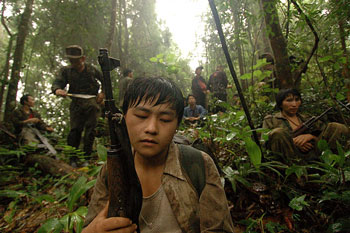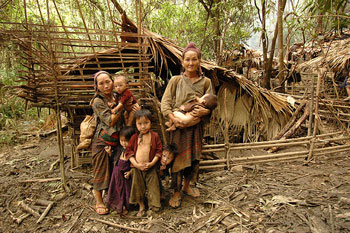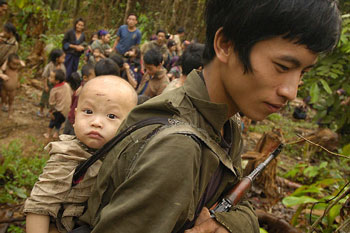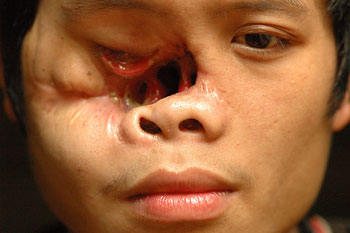 |
Still a Secret War
October 2006
|
||||||||||||
|
My satellite phone rang. It was my contact from the "Blackbird" network. He was in Thailand or the U.S., but I was not sure. I had hiked into the jungle alone, searching, lost for hours. He said, "You find them? They find you? No? Keep going!"
Suddenly they appeared like ghosts from the forest and snatched me from my exposed position, pulling me up into the jungle. When we stopped, I realized all six of them were afraid of me, but also excited. The soldiers wore battered army uniforms and carried antique AK-47s. They had never met anyone from the world outside the jungle - let alone a white American. For them, I was an alien from another world, or an aberration of an ally from the past. They stared at me in awe, my skin, my clothes; it was all foreign to them. Then the men innocently looked at everything I had, trying to discover what simple items like a paper clip were. Their favorite item was my blower brush, and they took turns blowing it at one another, laughing.
I found them through a humanitarian group in California called FactFinding.org. A few years ago the FactFinding group distributed satellite phones to the Hmong hiding in the jungle to document their treatment by the Lao Government. They used a loose network of individuals called the "Blackbirds," who do what they can to help the people hiding in isolation.
The ragtag Hmong guerrillas are one of many small groups estimated to number 12,000 still hiding in the mountains of Laos. For the last 30 years their only contact with the outside world is said to be with Lao and Vietnamese communist soldiers - hunting them and their families mercilessly. The Hmong jungle fighters are the remnants of a "Secret War," a counterinsurgency sponsored by the CIA during the Vietnam War. Both the Americans and the communists kept this war secret, even though it became one of the most intensive bombing campaigns in world history.
My satellite phone rang again; it was the Blackbird, "They find you? Good! You follow. You follow them all night. Don't stop. You go all night. Be careful. I pray for you. You no stop 3-4 days. Be careful! Don't stop! Keep going!"
Night fell and I struggled to follow the rebels for hours into an area no outsider had seen since the CIA left in 1975. There were no people, no villages, just darkness and Lao military patrols hunting us. In the dense jungle, I struggled on hands and feet up 65-degree mountains, falling constantly, my heart bursting, lungs spent, with soldiers pushing me up from behind and pulling from the front. I was a huge liability, and it made them edgy. Government soldiers were patrolling the area and I had taken away the rebels' greatest defense - their ability to appear and disappear like a panther.
Bill Lair, CIA veteran, counterinsurgency expert, and recognized founder of the CIA Secret Army, said to me about the Hmong, "They were probably the best guerrilla fighters anywhere in the world. They moved so quick over those rugged mountains, you'd swear a helicopter moved them around."
We stopped to eat. One soldier unloaded his U.S. military-issue backpack held together by a quilt of scavenged fabrics. He pulled out an assortment of pots and pans fabricated from U.S. and communist bombs. A few minutes later I was eating a boiled wild yam from those same bombs and some meat. A rebel fighter flashed a light into my bowl and I saw an animal paw. I looked up to see the guerrilla smiling, jumping up and down, acting like a monkey — imitating what I was eating.
By the third day I was suffering from exhaustion, covered in mosquitoes and leaches. My legs did not respond, and my feet were blistered, swollen and beginning to rot from moisture.
After 72 hours of climbing we reached their hidden village, where I found the saddest place I had ever seen.
I was speechless and unable to cope with the multitude of sorrow. Each of them wanted to tell their story and knelt at my feet with bowls of forest leaves as gifts, which was all they had to offer. Young men missing legs hobbled by on bamboo crutches. Children with bloated stomachs and no clothing screamed for food that didn't exist. Most of them, including the women and children, had bullet or shrapnel wounds, and all of them — terrified — hunted like animals.
Blia Shoua Her led me through his muddy makeshift mountain camp, to a small bamboo hut with no walls, built for me. He assigned several soldiers to provide 24-hour security during my two weeks in the jungle. Blia Shoua then advised me to keep all of my belongings packed and be ready to run at a moment's notice. This is the way his people in the jungle have lived for more than 30 years – bags packed, ready to go. He explained the entire village was impermanent since they have to flee so often from mountain to mountain. The Lao Army surrounds the group, rendering them unable to farm or raise livestock, forcing them to forage in the jungle for anything edible.
I came to visit Blia Shoua Her and his group because, they claim, Lao and Vietnamese Government soldiers ambushed them on April 6, 2006, while searching for food in the forest. The massacre resulted in 26 killed and 5 wounded. Only one adult male killed, the other 25 victims were women and children (17 children). In the days that followed another five infants died because their dead mothers could not breast-feed them. This is only one small incident out of thousands reported and documented since 1975. The Lao Government generally denies the jungle people exist or that any of this is happening.
Before I left the jungle, Blia Shoua Her told me his people wanted peace, freedom so they could farm in one place without constantly running. He said his group was not part of the Hmong rebel resistance, just civilians that defended themselves when attacked by their own government. They hope the Lao Government will allow them to surrender to the U.N. – a plan which the Lao Government spokesman also ruled out.
[Author's Endnote: The Hmong are probably the only guerrilla army in history to have enjoyed air superiority, led by American airpower and an assortment of nations. Though the Hmong are well adapted to running and hiding in the jungle, in recent years many experts have begun to wonder why the Lao Government has not mounted a full campaign to completely wipe them out. Many speculate the Lao Military is just using them for live-fire exercises.]
© Roger Arnold
Dispatches are brought to you by Canon. Send Canon a message of thanks. |
||||||||||||
Back to October 2006 Contents
|
|



